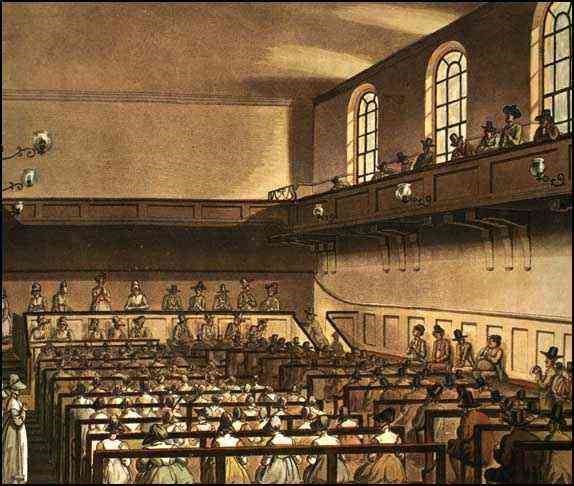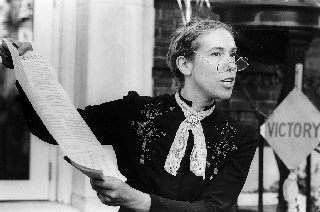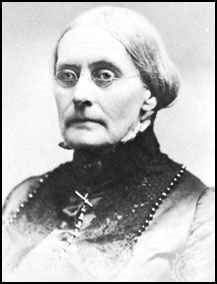 |
Susan Brownhill Anthony was born the daughter of Daniel and Lucy Anthony on February 15, 1820, in the town of Adams, Massachusetts. Her siblings included three sisters and two brothers. The family left Adams and moved to Battenville, New York in 1826. Susan was a very intelligent child, and it is said that she learned to read at the age of three. Her father was a cotton manufacturer and a 6th generation Quaker who believed in equal treatment for both boys and girls. Although unusual at the time, due to her father’s strong convictions, Susan and her three sisters had the same opportunity for advanced education as her two brothers. After the family moved to New York, she first attended the district school “Center Falls”, and later a school set up by her father. Mr. Anthony had set up the school to aid in the education of his employees and their family’s. She continued her education at a Philadelphia boarding school. While living in New York, the family’s business became very profitable, and the Anthony’s became one of the wealthiest family’s in Washington County. Quakers, formerly called The Society Of Friends, regard all humans as equal before God. The term “Quakers” was coined when the founder, George Fox, was arrested in 1656 for refusing to attend Anglican services or pay tithes. The judge reportedly told Fox “to quake in the presence of the lord”, and from that day on the Society of Friends became known as the Quakers.
 |
Early in 1849, Susan gave her first political speech for “The Daughters of Temperance”, outlining the abuses that women and children suffered at the hands of their alcoholic husbands. When her education was completed, Susan began teaching at Canajahorie Academy, a female academy near Rochester, New York in 1846. She continued teaching there until 1849. During a Women’s Rights Convention near the academy she met Amelia (Jenks) Bloomer and Elizabeth Cady Stanton. Together, they convinced Amelia to start her bi-weekly newspaper, “The Lily”. This newsletter promoted women’s suffrage, temperance, marriage law reform, and higher education for women. It quickly became a success over the next few years, reaching a circulation of over 4000 people. In the 1851 it began publishing women’s fashion articles, advocating dropping tight fitting corsets and petticoats for looser bodices, pantaloons, and shorter dresses. Susan and a few others started wearing this type of clothes, but most abandoned the new style stating that the ridicule it caused undermined their social reform movement ideas.
In 1868 Susan and Cady Stanton started the political weekly newsletter, “The Revolution”. This newsletter, considered radical at the time, spoke strongly against abortion. The authors considered abortion child murder A year later, in 1869, the two women formed a new organization, “the National Women’s Suffrage Association” or NWSA. This group campaigned against the constitutional amendments that they felt were unfair to women, particularly the 14th and 15th amendments. Neither of these amendments extended the right to vote, or the right to be counted in congressional representation to women, and the NWSA was outraged by this omission. In 1872, Susan Anthony attempted to vote for Ulysses S. Grant in a Rochester election as a protest to this omission, and was later arrested and found guilty of violating the voting rights act. Although found guilty during her trial on June 17th in 1873, she refused to pay the fine, and the case never went any farther. During the 1800’s, another group called the “American Woman’s Suffrage Association”, or AWSA was also active in the women’s rights movement. This group was much less militant than the NWSA, and was primarily only interested in gaining the right for women to vote. The AWSA published its own magazine, “The Woman’s Journal” featuring articles and cartoons by its members. It also produced the first “Women’s Voters Journal”, published in New York City.
 |
After several years of negotiations, the NWSA and AWSA merged in 1890 to become the “National American Women’s Suffrage Association” or NAWSA. Much later this group became known as “The League of Women Voters” and is still very much active today. Elizabeth Stanton became the first president of NAWSA, but Susan took over in 1892 and held the position for the next eight years. In 1900, at the age of 80, Susan Anthony retired from the president’s position, passing it on to Carrie Chapman Catt. An interesting side note is that in 1848, at the first NWSA convention consisting “of all those who thought that women should share equally with men in their government”, Frederick Douglass, an ex slave, was the only man who attended. From that day on, Frederick was an honorary member of the NWSA. In all future gatherings, Susan insisted that he be an honored guest who sat on their platform, and spoke with them. Susan never married or had children of her own, but helped raise her best friends, Elizabeth Stanton’s 7 children. She considered younger feminists her nieces, and they in turn referred to her as Aunt Susan.
 |
Susan was very outraged by slavery, and during the mid 1800’s was very much involved in the “Underground railroad”. This loose knit organization, said to have about 3000 members by the mid 1850, aided fugitive slaves by providing food, safe shelter, and money to the fleeing slaves. In the early 1900’s, as a prominent women’s rights historian, Susan, Elizabeth Stanton, and Matilda Gage published the four volume “History of Woman’s Suffrage”. Susan Brownhill Anthony died on March 13th, 1906 at the age of 86. She did not live to see the day in 1920 when the 19th amendment to the constitution was ratified, guaranteeing that women now had the right to vote. This was the culmination of a 72 year struggle, often called the only non-violent revolution in our country’s history. This amendment was ratified 100 years after the birth of Susan Anthony. Another one of Susan’s family’s early campaigns, temperance, came to conclusion in January 16, 1919 with the adoption of the 18th amendment to the constitution. This amendment established prohibition, or the outlawing of alcohol as the law of the land. This amendment was the nations first attempt at legislating morality based on the desires of a small percentage of vocal minority group. It resulted in a dismal failure and it was repealed on December 21, 1933 by the adoption of the 21st amendment. After her death, Susan was honored twice by the government by having her likeness placed on U.S Postage stamps, and once again in 1979 with the release of the Susan B. Anthony dollar coin.
Page created on 11/27/2000 12:00:00 AM
Last edited 11/27/2000 12:00:00 AM
